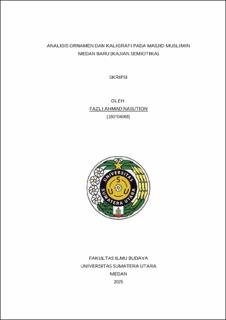Analisis Ornamen dan Kaligrafi pada Masjid Muslimin Medan Baru (Kajian Semiotika)
Analysis of Ornaments and Calligraphy at Mosque Muslimin Medan Baru (Semiotic Study)

Date
2025Author
Nasution, Fazli Ahmad
Advisor(s)
Suri, Nursukma
Khairawati
Metadata
Show full item recordAbstract
This research discusses the analysis of ornaments and calligraphy in the Muslimin
Medan Baru Mosque. The aim of this study is to describe the types of ornaments
and calligraphy, along with their denotative and connotative meanings, using a
semiotic approach. The theory used in this study is Roland Barthes' semiotics,
supported by Ferdinand de Saussure's theory. This research is a field study
utilizing a descriptive method, complemented by library research to gather data
from relevant literature in the field.The results of the research show that the
Muslimin Medan Baru Mosque features various types of ornaments that carry
meaning in semiotics, namely: Arab ornaments and Malay ornaments. The Arab
ornaments identified in the mosque include three basic patterns: circular,
rectangular, and twelve-sided patterns. The Malay ornaments include five types:
pucuk rebung (bamboo shoot), genting tak putus (unbroken tile), pucuk kacang
(pea shoot), awan larat (floating cloud), and daun pakis (fern leaf). Additionally,
four types of calligraphy (Khat) are found: Tsulust, Naskhi, Khufi, and
Riq‟ah.The semiotic analysis of the ornaments and calligraphy reveals both
denotative and connotative meanings. One example is the pucuk rebung Malay
ornament:Denotatively, the bamboo shoot motif symbolizes good hope, as
bamboo is a tree that does not easily fall, even in strong winds.Connotatively, the
pucuk rebung ornament symbolizes prosperity and happiness in human life.
Collections
- Undergraduate Theses [415]
